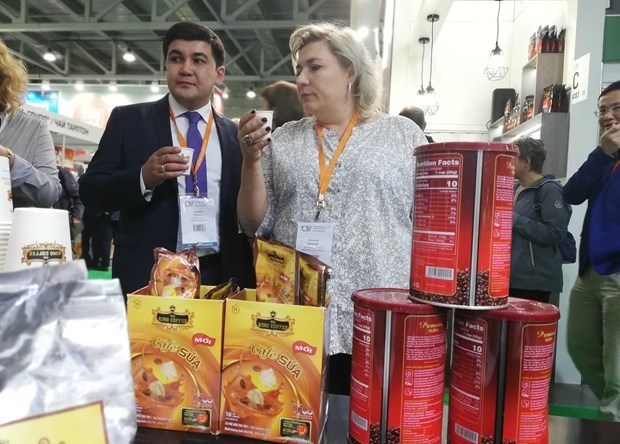Vietnam's food and beverage market attractive to foreign businesses
 Customers enjoy the taste of Vietnamese coffee. (Photo: VNA)
Customers enjoy the taste of Vietnamese coffee. (Photo: VNA)
Hanoi (VNA) - The annual food and beverage consumption of Vietnam accounts for about 15 percent of the country’s GDP and tends to increase in the near future, according to estimates by the Ministry of Industry and Trade.
In recent years, Vietnam's food and beverage market has become more and more attractive to foreign businesses through a series of transfers, mergers and acquisitions between foreign enterprises and domestic companies.
Prominent deals included CJ Group (the Republic of Korea)’s purchases of 65 percent of the shares of Minh Dat Food Co., Ltd. and 47.33 percent of the stake of Cau Tre Export Processing Joint Stock Company; Earth Chemical (Japan)’s acquisition of all the shares of A My Gia Joint Stock Company; and Daesang Corp (the RoK)’s purchase of all the stake of Duc Viet Food Joint Stock Company.
Fraser & Neave Ltd. (Singapore) purchased a 5.4 percent stake in Vietnam Dairy Products Joint Stock Company (Vinamilk), KKR (the US) bought 7.5 percent of Masan Group’s shares, and ACA Investments (Japan) bought a 20 percent stake of Bibo Mart...
Foreign enterprises’ presence in the Vietnamese market has opened up many opportunities for cooperation in investment and production in industrial parks, creating jobs for workers, boosting technology transfer and making products diversified and convenient.
However, this is also a big challenge for domestic businesses when their competitiveness is still weak, requiring innovation and adaptation efforts to integrate into the common trade "playground".
Along with diversifying products to meet consumer tastes, it is more important for food and beverage businesses to increase product quality right in the stages of the production chain.
All participating in the food supply chain from farmers and producers to processors need to create safe and quality products that meet the needs of consumers. In particular, good cooperation between the chain members is needed. This is a sustainable way to enhance the position of Vietnamese food.
Explaining the attractiveness of the food market to foreign enterprises, experts said that Vietnam is a country with abundant agricultural products and raw materials, which is very convenient for supplying raw materials for food and beverage production and processing.
On the other hand, with a population of over 96 million, over half of them are under 30, Vietnam is rated as one of the region's most potential food and beverage consumption markets.
The annual food and beverage consumption of Vietnam accounts for about 15 percent of the country’s GDP and tends to increase in the near future, according to estimates by the Ministry of Industry and Trade.
In fact, in recent years, the local food and beverage industry has been growing rapidly in both quantity and quality.
In 2018, food and beverage consumption grew strongly with an increase of 18 percent. Along with the development of the food and beverage industry is the growth of food packaging and equipment sector.
The demand of consumers in big cities for food and drinks is increasing and diverse, especially products of natural origin and nutritious ones.
The increasing trend of fast food in the Vietnamese market has brought a great opportunity to the food and beverage industry.
Convenience store chains have been expanded in size and become widespread, helping businesses in this industry to have more distribution channels.
Food sausage processing using European pasteurization technology at Hanoi branch of C.P Vietnam Livestock Joint Stock Company (invested by Thailand). (Photo:VNA)
Vietnam's food and beverage industry is expected to maintain strong growth momentum until 2020 with an average growth of 10.9 percent per year thanks to improved people's income and the trend of consuming valuable products.
In a quick survey of businesses in the industry conducted by Vietnam Report in September 2019, up to 66 percent of the respondents were confident that they would see revenue and profit growth in 2019, only 27 percent said their growth would be below 10 percent, and 7 percent said business results would not be changed as compared to 2018./.













